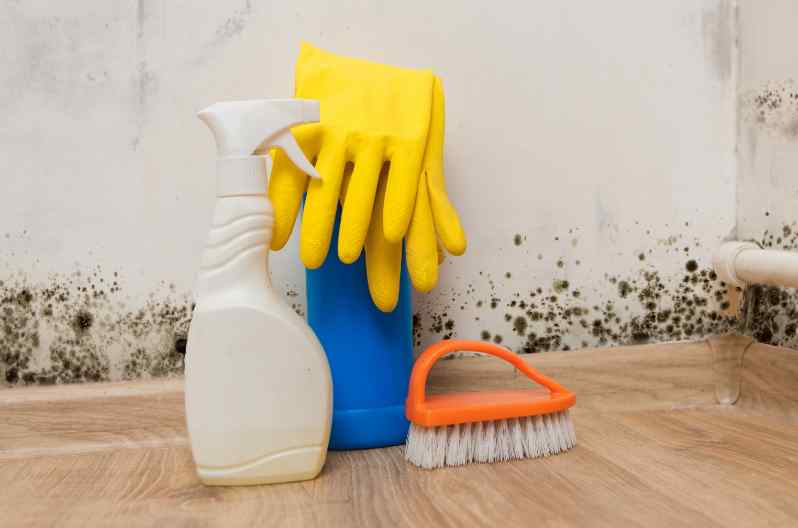Do you have mold? You just need to grab some bleach, right? Without a doubt, it is the most popular solution for treating moldy surfaces. And while bleach does kill mold, it’s not always the best solution. Bleach doesn’t always work on all surfaces, the smell can be overwhelming, and it leaves its own stains. Plus, it does nothing to stop future mold growth. We look at the most effective way to kill mold with bleach and when you need to call a mold remediation specialist.
Does Bleach Kill Mold?
Regular household chlorine bleach does kill mold. Use one cup of bleach per gallon of water and wipe or spray mold on surfaces. However, just because bleach kills surface molds doesn’t mean it will really solve your problem.
Liquid bleach cannot penetrate deep into walls, cabinets, and other porous materials. While it will kill mold on the surface, there still could be a problem underneath. Using chlorine bleach on mold is best for hard, non-porous surfaces like glass, metal, and natural stone.
Mold is a symptom of a moisture issue. Although household bleach does kill mold, it will come back as long as the moisture levels are right. Mold spores in the air will eventually form new colonies.
Lastly, even a diluted bleach solution can stain carpeting and fabrics. So it will kill visible mold on carpeting, curtains, or towels, but it’s not the best cleaner for the job.
How Long Does It Take For Bleach To Kill Mold?
Bleach will start killing mold on contact and you should see a difference in just a few minutes. However, it can take anywhere from thirty minutes to several hours for it to completely disappear. In some cases, you may need to clean the area a few times.
Does Bleach Kill Black Mold?
While so-called toxic black mold sounds scary, bleach is just as effective at removing it as any other mold. You can kill black mold with chlorine bleach. It is also effective on all other types of mold.
Talk to a local pro now. Certified Restoration Local mold remediation specialists offer 24-hour service and fast, free quotes.
How Do You Kill Mold With Bleach?
Here are the simple steps to killing mold with bleach and a spray bottle. You can safely deal with mold problems that are smaller than a three-foot by three-foot area. However, call a mold remediation professional for larger areas.
Tools & Supplies:
- Chlorine Bleach
- Warm Water
- 32 oz Spray Bottle
- Cloth or Disposable Towel
- Soft-Bristled Scrub Brush
- Funnel (optional)
- Rubber Gloves
- Eye Protection
Steps:
- Bleach has a strong smell, so always work in a well-ventilated space and take frequent breaks.
- Add a quart cup of bleach to the spray bottle, then top off with warm tap water. Although not necessary, a funnel makes filling the bottle easier. Shake gently to combine.
- Spray surfaces with the solution. While it will start killing mold immediately, it can take 30 minutes or more to completely remove the stain.
- After half an hour, wipe surfaces with a color-safe cloth or a disposable towel. Apply additional bleach if the mold remains.
- Scrub stubborn mold stains with a soft-bristled brush. Spray on more bleach as needed until the mold is completely gone.
- For added protection against future problems, spray the clean surface with bleach and let it air dry.
Caution: Never mix bleach with other cleaners, especially ammonia. Together they produce toxic fumes that can make you sick or even suffocate you.
Why Did the Mold Come Back After Cleaning?
While using bleach to kill mold does work, moisture is the problem. Mold is all around us and it will grow anywhere is there consistent water. The only way to permanently kill mold is to find and fix the water source. Otherwise, you will have new mold growth in weeks or even days.
While you can keep cleaning it, mold is also damaging your home. Mold’s role in nature is to decompose organic materials. So even if you think you’re keeping it under control, it’s slowly eating away at your walls or cabinets.
You can take care of some leaks and moisture sources yourself. Replacing worn-out washers or fixtures can stop many leaks. Using exhaust fans can resolve some humidity and condensation issues. Once you deal with the problem, disinfect the area again with bleach as a precaution.
However, it’s time to call in the mold removal experts if you are using bleach more than once a month, you cannot find the moisture problem, or the area is larger than ten square feet. They will inspect your home, determine the moisture source, and create a remediation plan specific to your problem.
Do you still have mold even after cleaning with bleach? If you are tired of trying to kill mold with bleach, our local restoration specialists are here to help. They not only clean the mold but find and fix what causes it. Call 1-888-681-1071 now for a free estimate on mold removal services.





